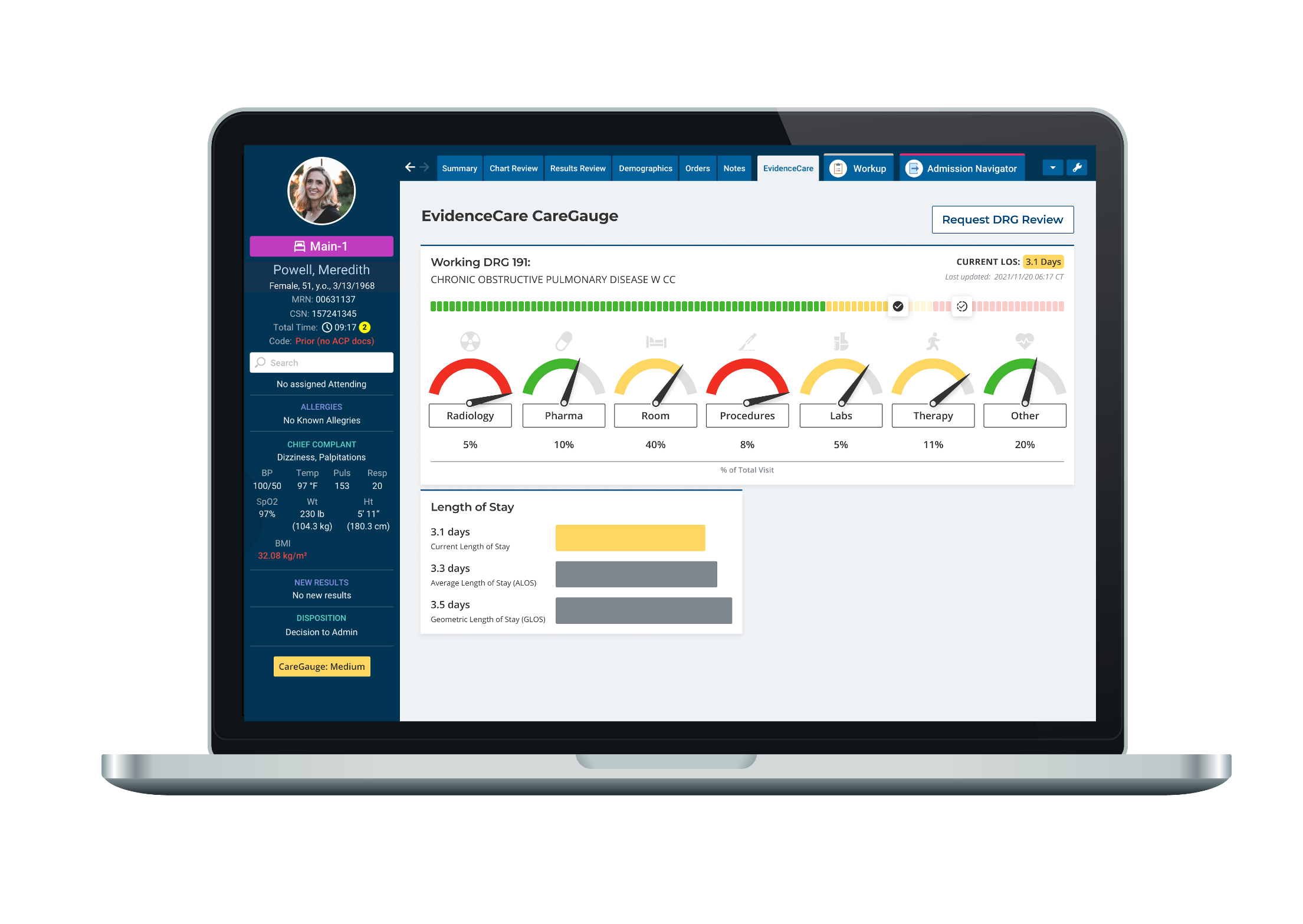Hospital Length of Stay
In comparison with other nations, the acuity of the US healthcare system is relatively good. But it faces serious challenges regarding cost and the quality of care. With both matters, hospital length of stay (LOS) is a key factor.
According to a report by the American Hospital Association, there has been a 19% rise in patient length of stay from 2019 to 2022.
Such a rise is concerning beyond the time a patient spends in the hospital, as LOS also has a significant impact on overall healthcare. The report shows a strong correlation between increased LOS and negative consequences on patients.
By forcing patients to stay in the hospital longer than necessary, discharge delays affect health outcomes or slow recovery. Some risks patients face with prolonged stays include hospital-acquired patient complications such as infections and falls and increased costs.
Along with increasing hospital readmission rates, prolonged LOS also impacts staff experience as it puts more pressure on the already overwhelmed workforce. Therefore, monitoring and putting measures in place to reduce your average LOS is essential, as it indicates your facility’s efficiency.
If you’re wondering why length of stay is important, read on to find out how it can impact your facility and patients and how to address it.
Factors Affecting Length of Stay in Hospital
From the moment a patient is admitted to the hospital, numerous factors will influence their journey to discharge. As a hospital administrator or clinical leader, understanding the factors affecting length of stay in hospitals is essential for developing strategies to optimize it and enhance patient care.
The first factor influencing the average length of stay is the severity of the patient’s condition. Patients who require intensive treatment, monitoring, and recovery support will spend more time in the hospital. This can increase further if the patient has underlying health conditions or complications that arise during treatment.
In most cases, diagnostics must be performed on patients to confirm the condition and its severity before treatment begins. Depending on the type of tests needed and whether it’s necessary to book in advance, it may take some time before the test results are available.
Once the results are out, the patient may require specialized care and consultations. If such resources are available in your facility and easily accessible, treatment can proceed swiftly. However, if they’re unavailable, you must schedule them in another hospital and proceed with treatment once the results are out. As you can imagine, this process will increase the patient’s LOS.
Moreover, if the patient requires surgical intervention, there will be a need for post-operative recovery and rehabilitation before they’re discharged. Depending on the type of surgery and the extent of the condition or injury, the patient’s length of stay may increase by a few days or more.
Key Concepts to Understand
Knowing the factors that influence LOS is great. However, for you to be able to address them effectively, there are some key concepts you must first understand. They include:
Inpatient days vs. length of stay
When it comes to inpatient days vs. length of stay, it’s easy to think of them as the same thing, but there’s a slight distinction. Inpatient days are the total number of days a patient has been admitted to the hospital. In contrast, LOS is the duration between admission and discharge, calculated by deducting the day of admission from the inpatient days.
Hospital length of stay benchmarks
For healthcare institutions to accurately measure and compare patients’ duration in the hospital, there are set standards to use. These are referred to as hospital length of stay benchmarks that make it easy to compare data from different facilities.
Average length of stay formula
To have a clear picture of how your facility is performing concerning length of stay, you must look beyond individual patients. For this, you’ll need to calculate the average length of stay using the average length of stay formula below:
Average length of stay of your patients = Total length of the stay of all patients / the number of patients
Consequences of Increased Length of Hospital Stay
Longer than medically required hospital stays have significant consequences for both patients and healthcare facilities. The consequences of increased length of hospital stay include:
1. Increased Healthcare Costs
When patients stay at your facility longer, their bed occupancy increases, along with their resource utilization, including staff time, medications, and diagnostic tests. As a result, the cost of care rises significantly, thus straining the facility’s budget and financial performance.
2. Bed Shortages and Reduced Capacity
If patients are admitted longer than needed, accommodating new patients may become challenging due to the reduced bed capacity.
As a result, your facility may become overcrowded, making it even more challenging for providers to offer timely care. This will compromise patient outcomes or force you to refer patients to other facilities.
3. Risk of Hospital-Acquired Infections (HAIs)
Another challenge with an extended length of stay in hospital is the increased risk of Hospital-Acquired Infections (HAIs). These may come through medical interventions or infection susceptibility, increasing complications, and recovery times.
4. Increased Emotional and Psychological Stress
Another effect of an extended length of stay in the hospital is increased emotional and psychological stress for patients and their loved ones. Besides being away from each other longer, it increases uncertainty about the patient’s well-being.
5. Decreased Patient Satisfaction
Naturally, patients want to be discharged when they start feeling better. Considering that many reasons for long hospital stays stem from inefficiencies, it may lead to dissatisfaction, affecting patient loyalty and the perception of the quality of care you offer.
6. Reduced Hospital Efficiency
Extended hospital length of stay can disrupt workflows and decrease overall operational efficiency. Care teams may face challenges in managing patient turnover and coordinating care effectively, leading to potential delays in treatment and discharge planning.
7. Impact on Quality Indicators and Accreditation
As a facility, the conclusions accrediting bodies draw after assessments will significantly affect the perception of your facility, hence performance. In addition to adherence to evidence-based practices, patient outcomes, and efficiency, LOS is one of the factors assessed.
If LOS is long, it will negatively impact quality indicators and accreditation status.
8. Strain on Healthcare Staff
Under normal circumstances, healthcare providers have long and demanding shifts. As the average hospital length of stay increases, so does their workload, increasing the likelihood of burnout on your team.
Reducing Length of Stay
There are notable benefits of reducing the length of stay in hospitals, including optimizing patient care, enhancing efficiency, and improving resource utilization.
By implementing effective strategies and evidence-based practices, you can streamline patient pathways, expedite recovery, and ensure timely discharges without compromising the quality of care.
Here are the top strategies for reducing length of stay:
1. Care Coordination and Multidisciplinary Teams
Accurate diagnosis and effective treatment of patients usually involve going through caregivers specialized in different areas. Developing a multidisciplinary team ensures that patients do not need to be referred to other facilities or wait for extended periods to receive the necessary attention.
If you combine this with team collaboration, patients will receive the right interventions at the right time, avoiding delays in treatment and discharge planning.
2. Early Discharge Planning
Another effective method of reducing the length of stay in hospitals is initiating discharge planning early in the patient’s care. This involves engaging patients and their families in discussions about post-discharge care needs and ensuring necessary support is available upon discharge.
Doing so will prevent unnecessary delays once a patient is ready for discharge and expedite the transition to post-acute care settings or homes.
3. Utilizing Clinical Decision Support Systems (CDSS)
Arguably the biggest determinant of LOS is the quality of care you offer. If you can diagnose accurately and determine the best treatments early, the sooner the patient will recover and be ready for discharge.
Leveraging Clinical Decision Support Systems (CDSS) to streamline workflows and enhance care quality is a great way to achieve this. These solutions have access to patient medical history and tons of data to offer clinicians evidence-based guidance, aiding in accurate diagnosis and treatment decisions.
Hospital Length of Stay Software
Hospital Length of Stay software is a type of CDS software designed to optimize patient care and streamline hospital operations by efficiently managing and reducing patients’ time as inpatients.
EvidenceCare’s LOS software, CareGauge, leverages data analytics, artificial intelligence, and evidence-based protocols to improve clinical decision-making, care coordination, and discharge planning. It analyzes huge amounts of hospital cost data and uses predictive analytics to offer valuable insights into factors influencing LOS, such as patient progress and treatment response.
In addition, EvidenceCare’s CDSS platform incorporates evidence-based care pathways and protocols, guiding healthcare providers in delivering efficient and standardized patient care. This reduces variations in treatment, improves outcomes, and shortens LOS.
To help streamline operations, CareGauge’s length of stay reporting software comes with a resource allocation feature to see which providers and orders are causing the highest widest range of clinical variation. These insightful, easy-to-read reporting capabilities allow you to optimize resources to minimize bottlenecks that can extend hospital stays.
CareGauge has been designed with quality care and length of stay optimization in mind, allowing your facility to offer better patient outcomes while operating efficiently. Most importantly, you can easily integrate it with your existing Electronic Health Record (EHR) system, with a design that’s non-invasive to clinicians.
Schedule a demo today to enhance patient care, improve efficiency, and reduce healthcare costs with EvidenceCare’s CareGauge length of stay software.










